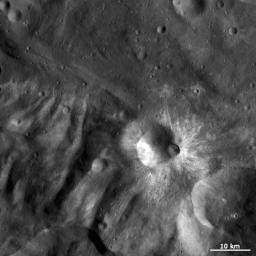
|
Bright Rayed Craters in Tuccia Quadrangle
- Click the image above for a larger view
- Full-Res JPEG (1024 x 1024) (127.8 kB)
- Full-Res TIFF (1024 x 1024) (1.1 MB)
Caption:
This Dawn FC (framing camera) image is dominated by bright rayed craters of different sizes. The most prominent bright rayed crater is the approximately 8km diameter crater in roughly the center of the image. This crater is named Tuccia and the quadrangle in which it is located is named after it. Towards the bottom of the image its bright rays extend for over 10km but towards the top the rays are much less extensive. Tuccia crater has a smaller, fresher, younger crater on its rim which also seems to have bright rays emanating from it. It is clear that this smaller crater is younger because it overprints the larger crater and has a fresher, sharper rim than Tuccia crater. Slightly above these craters is a much smaller, roughly 2km diameter, bright rayed crater. To the left of this crater there is a patch of bright material that is associated with craters that are only a few pixels in diameter. There is also a good example of the hummocky (i.e., wavy/undulating) terrain of Vesta's south polar region in the bottom left of the image. Tuccia crater has been emplaced onto this hummocky terrain.
This image is in Vesta's Tuccia quadrangle and the center latitude and longitude of the image is 38.8°S, 200.2°E. NASA's Dawn spacecraft obtained this image with its framing camera on October 17th 2011. This image was taken through the camera's clear filter. The distance to the surface of Vesta is 702 km and the image has a resolution of about 70 meters per pixel. This image was acquired during the HAMO (High Altitude Mapping Orbit) phase of the mission.
Background Info:
The Dawn mission to Vesta and Ceres is managed by NASA's Jet Propulsion Laboratory, a division of the California Institute of Technology in Pasadena, for NASA's Science Mission Directorate, Washington D.C. UCLA is responsible for overall Dawn mission science. Dawn's VIR was provided by ASI, the Italian Space Agency and is managed by INAF, Italy's National Institute for Astrophysics, in collaboration with Selex Galileo, where it was built.
More information about Dawn is online at http://www.nasa.gov/dawn and http://dawn.jpl.nasa.gov .
Cataloging Keywords:
| Name | Value | Additional Values |
|---|---|---|
| Target | 4 Vesta | |
| System | Main Belt | |
| Target Type | Asteroid | |
| Mission | Dawn | |
| Instrument Host | Dawn | |
| Host Type | Orbiter | |
| Instrument | Framing Camera (FC) | |
| Detector | ||
| Extra Keywords | Crater, Grayscale, Infrared | |
| Acquisition Date | ||
| Release Date | 2011-11-16 | |
| Date in Caption | ||
| Image Credit | NASA/JPL-Caltech/UCLA/MPS/DLR/IDA | |
| Source | photojournal.jpl.nasa.gov/catalog/PIA15081 | |
| Identifier | PIA15081 | |
